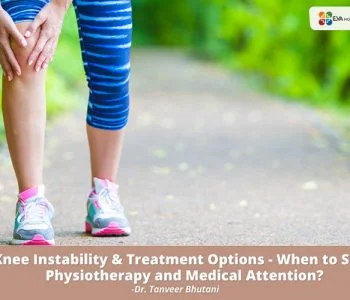 knee replacement surgery
knee replacement surgery
Knee Instability & Treatment Options – When to Seek…
The painful, wobbly, and unstable feeling of a loose knee cap is commonly caused by an injury that has either sprained or torn the ligaments.
Anterior cruciate ligament or meniscus injury may also cause knee instability and pain.
The kneecap is connected to the thigh bone(femur) above and the shin bone(tibia) below.
It moves up & down in this groove as you move your knee.
Sometimes the knee ‘gives out’, or the kneecap moved out of this groove. This is called knee instability.
The most common symptom is a sensation that the knee has moved out of place.
There is usually swelling, pain, discomfort in movement, and probably a visibly deformed knee.
People who are at risk of knee instability include sportspersons and dancers. A sports injury specialist’s advice is important in such a case.
Causes
Injury to Knee Ligament
Such injuries occur due to a strong impact wherein the knee gets forcefully bent at an unusual angle, injuring the ligaments.
The kneecap is held in place via ligaments. Ligaments are the fibrous tissues that connect the bones to muscles.
An injury may make a partial or complete tear in the ligaments.
The minor tears normally heal with simpler remedies, whereas serious tears may require surgery.
There are three types of ligament tears:
ACL Tears
The ACL or the anterior cruciate ligament tear puts pressure on the injured leg and makes it difficult to walk.
The knee joint feels dislocated and there is a decreased range of motion.
A patient with an all tear can bend and flex the knee in a normal and painless way.
The treatment involves more invasive procedures.
MCL Tears
The MCL or the Medial Collateral Ligament tear is caused by a direct strike on the knee cap. there is usually swelling, redness, and pain that lasts a few hours.
A severe MCL tear makes the knee unstable and causes pain and soreness on the medial or inner part of the knee. Most MCL tears can heal without surgery unless accompanied by injuries to other ligaments.
PCL Tears
The PCL or Posterior Cruciate Ligament gets damaged usually by falling directly on the frontal knee.
As an isolated condition PCL tear can be treated non-surgically, although surgical treatment options are also there for PCL injuries.
Surgery is usually only recommended for serious tears & multiple ligament tears.
Non-Ligament Causes
It is also possible for people to experience instability symptoms owing to knee osteoarthrosis and patellar instability.
Osteoarthrosis, wears down the cartilage, inflicting pain, swelling, and stiffness.
Patellar instability can also lead to kneecap dislocation. You get a feeling as if the knee is going to pop out, leading to instability, although there is no ligament injury.
Treatment
Your surgeon diagnoses your condition by compiling your medical history and results of clinical examination.
You may also have to undergo certain tests such as X-rays, MRI or CT scans to confirm the diagnosis.
Treatment of instability depends on the severity of the injury, as established by the diagnostic reports. Both surgical and non-surgical options are there for knee instability.
Primary treatment of dislocations includes:
- Resting the knee is the first step,
- Ice fomentation
- Compression- use of braces or compressor.
- Nonsteroidal anti-histamine drugs are prescribed to relieve the pain
- Targetted physiotherapy is begun after the pain subsides a little, to lend muscular strength to the muscles that hold the knee.
A sports injury specialist or a physiotherapist can design an exercise procedure to deal with knee-buckling as a treatment and also as preventive care.
The exercise program is focused on strengthening leg muscles, keeping the knee cap aligned, and improving the range of motion in the legs, and improving flexibility.
Surgical treatments largely depend on the severity of the injury.
The ACL tears are usually repaired with a procedure called ACL Reconstruction.
It involves reconstructing the damaged ligament to restore the normal structure of the knee joint.
Several other procedures are possible, as the surgeon decides, such as the lateral retinacular release, realigning the quadriceps mechanism, or tibial tubercle transfer (TTT).
A Word From Eva
Most medical treatment for instability is aimed at brace protection of the ligaments, improving the walk, range of motion, and return the patient to normal activity as early as possible.
The sooner the problem is addressed, the better it is. Instead of worrying at home and dealing with the pain, have a discussion with your doctor at Eva Hospital about your treatment options and choose what suits you best.